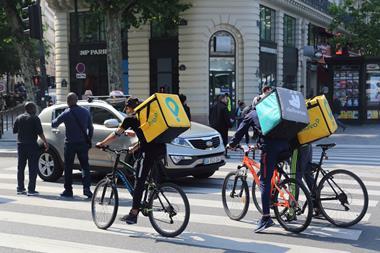Managing director warns of ’enormous fight’ over talent and ’fairly limited studio space’
Hollywood is somewhat healing after the Writers Guild of America and the Alliance of Motion Picture and Television Producers reached a new three-year deal that saw one of the longest strikes in the entertainment industry’s history come to an end.

However, as the volume of filming resurges in the UK post-strike, an “enormous fight” is on the cards over talent and “fairly limited studio space”, which will “undoubtedly” create “some work and pressures” for the insurance industry.
That was according to Spotlite Claims managing director Marion Jones, who recently spoke to Insurance Times about the latest emerging risks in the film and television sector, what can be done to mitigate those risks and how the claims journey in that space can be improved.
Loss adjuster Spotlite Claims was established by Jones in 2011 and in April 2022 the firm was bought by Van Ameyde-owned Woodgate and Clark.
The business specialises in handling crossclaims in the film, TV and advertising and contingency sectors across the UK and internationally.
Speaking about risks in the industry, Jones first highlights that the filming sector in the UK has a “great reputation” and if an “awful lot of production” suddenly happens at the same time such as after an industry hiatus, it can create “pressure” on available studio space.
This, as a result, “tends to push production companies to have to find [filming locations such as] disused warehouses” and old factories.
“If they’re not set up as sound stages, even with the best [production company] in the world there will be some problems,” she says.
Jones highlights the “biggest risk factor in terms of construction” is asbestos, which can have “quite a devastating effect” if the production company is not aware of it.
And if it is discovered, filming must be stopped until it is “dealt with”, which can interrupt business and have damaging cost implications.
“[Filming] might even have to move to a different space,” she adds.
Talent
In terms talent, Jones says the UK is home to “some great crews”, but it is “under resourced” when it comes to experienced staff – that creates an issue as the revival of film puts pressure on the demand for talent.
Read: Entertainment industry ‘not out of the woods yet’ despite recovery – Allianz
Explore more risk managment content here or discover other interviews here
“That will potentially affect a lot of the insurers’ time element coverages because if [a member of the film crew] is not used to dealing with certain types of equipment, you could end up with physical damage to that equipment, which then puts it out of use,” she adds.
“That could impact the actual production and the filming schedule.”
Jones also notes that while most entertainment is “shot digitally” nowadays, there has been a recent “resurgence of film” shooting because “some directors and artists like the granularity of the film”.
Film cameras capture all real images taken from the lens, while digital ones must convert that light into a digital signature.
While Jones feels film is on the rise again, she warns “there are very few processing laboratories globally now” and explains that it can take material weeks to be processed, which increases the risk of problems, such as tears or nicks in the film.
Jones shared her loss adjusting firm recently worked on a claim regarding an autumnal shoot in a vineyard for a billboard, which included a mixture of live action and still photography.
The photography material had to be sent to Germany to be processed and, as a result, was not completed for a week.
She also highlights that on the £1.8m budget shoot, ”all of the stills portion was destroyed and then you’re back into a reshoot scenario”.
And she warns that if production companies do not “hear about the damage until quite a considerable period [of time] later” it “might be very difficult to restage the shoot” in the same way that it was originally filmed.
Collaboration
Considering how insurance firms can mitigate risks, Jones says that “there’s always been that opportunity for brokers, insurers and adjusters to work together in a more joined up and cooperative way”.

And she acknowledges that she is “seeing more cooperation and working together for the best interest of the insured to try and get the best outcome for them” – driven by the likes of generative artificial intelligence (AI) and other technology improving the likes of workflows and communication.
Jones also points to the use of virtual production – the modern alternative to a green screen – as an opportunity for firms to see a “significant reduction in risk” because “everything can be contained in a studio”.
Through the use of virtual production, the risk of actors and actresses injuring themselves on uneven ground or due to adverse weather conditions, which creates pauses in production, can be reduced.
Or, in the case of the vineyard incident, a background plate could have been used.
Moving ahead, Jones highlights that she would like to see loss adjusters be provided with technology that can help them do their job “a lot more efficiently”, such as when comparing artists’ schedules in the event of an illness.
When that happens currently, it involves “a wall full of all the different possible permutations and a lot of moving of bits of paper”, she says.
“I’m hoping that AI might help to deal with some of those problems – you just feed the data in [and] say ’these are my parameters and this is who I’ve got available’ – that might be quite interesting.”

She was selected for the Women in Journalism Senior Mentoring Scheme in 2019 and, in 2022, went on to win the Highly Commended Award in the Most Promising Newcomer category at the British Insurance Brokers’ Association (BIBA) Journalist and Media Awards.
At BIBA’s 2023 awards, she was shortlisted for the Best Investigative Journalism category.View full Profile
















































No comments yet